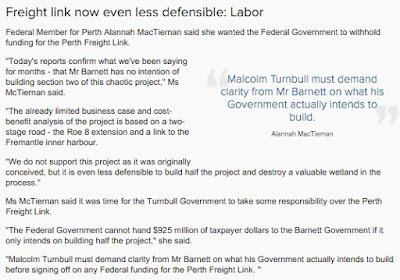Rural and Regional
Affairs and Transport Reference Committee
The Australian Senate’s Rural and Regional Affairs and
Transport Reference Committee (subsequently referred to as “the Committee”) published
a report of its enquiry into the Role of Public Transport in Delivering
Productivity Outcomes in December 2014.
 The committee made the following recommendations:
The committee made the following recommendations:
1. Public
transport infrastructure should be considered as nationally-significant
infrastructure, alongside private transport infrastructure such as road
construction.
2. Wider
economic costs and benefits, including social and economic connectivity,
environmental factors, active lifestyle benefits, safety factors and avoided
costs and benefits be factored into transport project analysis.
3. Given
the productivity cost of capital city congestion, all levels of government
interested in increasing national productivity consider backing solutions to
congestion, including public transport.
4. When
addressing congestion and other transport problems, a range of reasonable
solutions be examined, including the publication of cost-benefit analysis,
before decisions on funding are made by government.
5. Smaller
cost projects, especially so-called smart projects involving the more efficient
use of existing infrastructure, or the more effective integration of routes and
modes, be prioritised according to the positive benefits they produce.
6. The
Australian Government fund transport – including road and rail projects – on a
mode-neutral basis, based on assessed merit.
7. The
Australian Government take a leadership role on urban policy, working with the
states and territories, given the strong link between transport and urban
planning.
STCWA made a public submission to the enquiry and provided
evidence at a hearing in Perth.
STCWA applauds the Committee for being engaged with this timely issue
and is pleased to note that a number of recommendations we provided to the
enquiry are reflected in the Committee’s recommendations.
The STCWA’s submission is consistent with the Committee’s
recommendations that:
· - Public transport be considered nationally
significant infrastructure;
· - Wider Economic Benefits (WEB’s) be included in
project appraisals;
· - Smaller cost projects being prioritised
according to the benefits produced.
The Committee’s recommendation the Australian Government
take a leadership role on urban policy, given the strong link between transport
and urban planning is consistent with the spirit of our recommendation that simply
providing more transit in the absence of sound urban design practices conducive
to the creation of walkable cities will be futile. In the words of our submission: The issue is locality design that supports walking and cycling, that
will also support public transport that leads to well-functioning cities.
The recommendation to publish cost-benefit analysis prior to
funding decisions being made is strongly endorsed by the STCWA and is entirely consistent
with our submission to the Assistant Minister for Infrastructure and Regional
Development on a proposed Project Appraisal Framework, to be developed by the
Bureau of Infrastructure, Transport and Regional Economics, in consultation
with state and territory governments.
Notwithstanding a number of sound recommendations made by
the committee, the STCWA is disappointed the Committee has failed to recommend
support for the application of land value capture techniques to help fund the
cost of future transit.
Evidence provided to the Committee by a number of credible experts
underscored the viability of funding public transport infrastructure from
increases in land value linked to the provision of transit. The key is to hypothecate the extra
revenue generated by rates and taxes from the additional increase in property
prices generated by the provision of public transport to fund the capital
and/or operating cost of mass transit. Government may also wish to enter into
Public Private Partnerships with the private sector that takes expenses off the
Government’s books and couples transit infrastructure provision with
development of new Pedestrian and Transit Oriented Developments (POD/TODs).
The STCWA would also have liked to see the Committee
recommend the Commonwealth Government develop new national guidelines for the
consistent application of road user charges. Congestion charging and parking
levies can help spread the peak, encourage mode shift to space-efficient mass
transit systems, and provide funding streams to meet capital and operating
costs of public transport. In particular, STCWA argues State Governments should
plan location and time specific road user charges as a means of congestion
management as part of a whole of city strategy. However, STCWA cautions against
using tolls to recover the cost of individual road projects as they distort the
potential for a whole of city approach.
Moreover, recent investments in toll roads have been loss-making due to
forecasting errors informed by flawed traffic models over estimating projected
traffic flows.
In conclusion, the STCWA is pleased to note the Australian
Senate has become engaged with the issues pertaining to urban public transport
and recognise transit’s key role in fostering productivity growth and enhancing
quality of life. STCWA is
concerned the Federal Government refuses to fund urban public transport in
light of the fact the Commonwealth collects 80% of the country’s tax
revenue. Australia is one of the
world’s most highly urbanised societies and is experiencing rapid population
growth. In order to compete
successfully in a highly globalised world, the country will have to bolster its
productivity growth. Public transport (coupled with sound local initiatives to
enhance walkability through improved neighbourhood design) can play a key
enabling role in this transition. Better urban design coupled with enhanced
provision of mass transit infrastructure will also help improve Australia’s
resilience to future oil supply shocks and fuel price rises associated with the
peaking of conventional global oil supplies. A less car dependent urban future
will also help play a role in mitigating climate change by reducing the
transport’s sector’s production of carbon pollution.
Written by Stephen Kovacs, Committee Member. Posted by Ian Ker, Convenor, STCWA











































